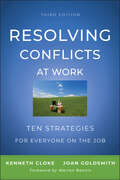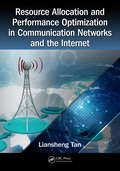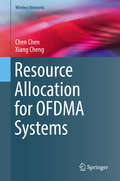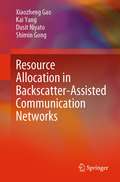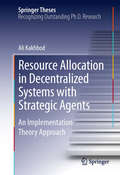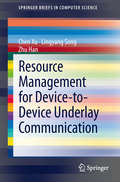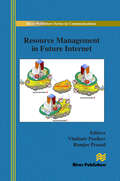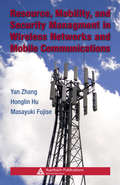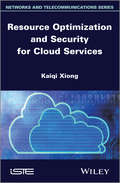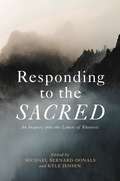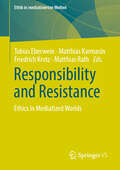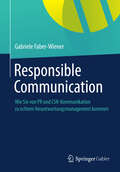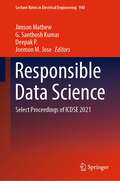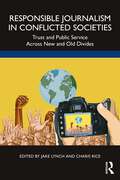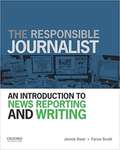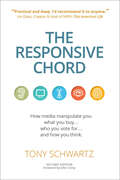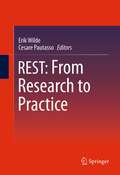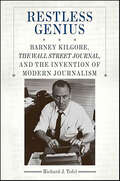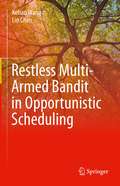- Table View
- List View
Resolving Conflicts at Work
by Kenneth Cloke Warren Bennis Joan GoldsmithHere is a completely updated edition of the best-selling Resolving Conflicts at Work. This definitive and comprehensive work provides a handy guide for resolving conflicts, miscommunications, and misunderstandings at work and outlines the authors' eight strategies that show how the inevitable disputes and divisions in the workplace actually provide an opportunity for greater creativity, productivity, enhanced morale, and personal growth. This new edition includes current case studies that put the focus on leadership, management, and how organizations can design systems to change a culture of avoidance into a culture of creative conflict. The result is a more practical book for today's companies and the people who work in them.
Resolving Conflicts at Work
by Joan Goldsmith Kenneth ClokeThe classic text on resolving workplace conflicts, fully revised and updatedResolving Conflicts at Work is a guide for preventing and resolving conflicts, miscommunications, and misunderstandings at work, including dozens of techniques for revealing how the inevitable disputes and divisions in the workplace are actually opportunities for greater creativity, productivity, enhanced morale, and personal growth. In the third edition of this text, all chapters are completely infused with additional content, updated examples, and new case studies. Like its predecessors, it identifies core strategies for preventing and resolving both intermittent and chronic conflicts in the workplace. In addition, the bookIncludes a new foreword by Warren Bennis, which represents his most recent thinking about judgment calls and candid communications in the workplacePresents new chapters on leadership and transformational conflict coaching, and organizational systems designThis definitive and comprehensive work provides a handy guide for managers, employees, union representatives, human resource experts, and consultants seeking to maintain stable and productive workplaces.
Resource Allocation and Performance Optimization in Communication Networks and the Internet
by Liansheng TanThis book provides a comprehensive introduction to the underlying theory, design techniques and analytical results of wireless communication networks, focusing on the core principles of wireless network design. It elaborates the network utility maximization (NUM) theory with applications in resource allocation of wireless networks, with a central aim of design and the QoS guarantee. <P><P> It presents and discusses state-of-the-art developments in resource allocation and performance optimization in wireless communication networks. It provides an overview of the general background including the basic wireless communication networks and the relevant protocols, architectures, methods and algorithms.
Resource Allocation for OFDMA Systems (Wireless Networks)
by Chen Chen Xiang ChengThis book introduces the sources and historic collection campaigns of resource allocation in wireless communication systems. The unique characteristics of MIMO-OFDMA systems are thoroughly studied and summarized. Remarks on resource allocation and spectrum sharing are also presented, which demonstrate the great value of resource allocation techniques, but also introduce distinct challenges of resource allocation in MIMO-OFDMA systems. Novel resource allocation techniques for OFDMA Systems are surveyed from various applications (e.g., for unicast, or multicast with Guaranteed BER and Rate, subcarrier and power allocation with various detectors, low-complexity energyefficient resource allocation, etc.) in this book.Due to the high mobility and low latency requirements of 5G wireless communications, this book discusses how to deal with the imperfect CSI. It also discusses how to deal with e.g., throughput maximization, outage probabilities maximization and guarantee, energy efficiency, physical-layer security issues with feedback channel capacity constraints, in order to characterize and understand the applications of practical scenes.This book will target professionals & researchers working in the fields of Wireless Communications and Networking, Resource Allocation and Transmissions. Advanced-level students in electrical engineering and computer science will also find this book useful as a secondary textbook.
Resource Allocation in Backscatter-Assisted Communication Networks
by Xiaozheng Gao Kai Yang Dusit Niyato Shimin GongThis book investigates the resource allocation in backscatter-assisted communication networks. With the development of backscatter communications, integrating backscatter communication technology into traditional communication networks can improve the network performance significantly. To fully improve the performance of backscatter-assisted communication networks, resource allocation is of special importance. It is worth to mention that the resource allocation in backscatter-assisted communication networks is more challenging than that in traditional communication networks, and the tradeoff of the performance between backscatter communications and traditional communications needs to be carefully considered. In this book, considering that game theory is an attractive tool for developing and analyzing distributed, flexible, and autonomous networks, we develop the auction-based time scheduling schemes, contract-based time assignment scheme, and evolutionary game-based access point and service selection scheme for the backscatter-assisted radio-frequency-powered cognitive networks, where some important properties such as individual rationality are considered. We also employ the optimization approach and develop a relay mode selection and resource sharing scheme for backscatter-assisted hybrid relay networks to improve the throughput. We believe that the developed resource allocation schemes in this book can provide useful guidance for the design of backscatter-assisted communication networks and future Internet of Things. Graduate students, researchers, and engineers in the field of communication networks can benefit from the book.
Resource Allocation in Decentralized Systems with Strategic Agents
by Ali KakhbodThis thesis presents a significant contribution to decentralized resource allocation problems with strategic agents. The study focused on three classes of problems arising in communication networks. (C1). Unicast service provisioning in wired networks. (C2). Multi-rate multicast service provisioning in wired networks. (C3). Power allocation and spectrum sharing in multi-user multi-channel wireless communication systems. Problems in (C1) are market problems; problems in (C2) are a combination of markets and public goods; problems in (C3) are public goods. Dr. Kakhbod developed game forms/mechanisms for unicast and multi-rate multicast service provisioning that possess specific properties. First, the allocations corresponding to all Nash equilibria (NE) of the games induced by the mechanisms are optimal solutions of the corresponding centralized allocation problems, where the objective is the maximization of the sum of the agents' utilities. Second, the strategic agents voluntarily participate in the allocation process. Third, the budget is balanced at the allocations corresponding to all NE of the game induced by the mechanism as well as at all other feasible allocations. For the power allocation and spectrum sharing problem, he developed a game form that possesses the second and third properties as detailed above along with a fourth property: the allocations corresponding to all NE of the game induced by the mechanism are Pareto optimal. The thesis contributes to the state of the art of mechanism design theory. In particular, designing efficient mechanisms for the class of problems that are a combination of markets and public goods, for the first time, have been addressed in this thesis. The exposition, although highly rigorous and technical, is elegant and insightful which makes this thesis work easily accessible to those just entering this field and will also be much appreciated by experts in the field.
Resource Allocation in Network Function Virtualization: Problems, Models and Algorithms
by Song Yang Nan He Fan Li Xiaoming FuNetwork Function Virtualization (NFV) has recently attracted considerable attention from both research and industrial communities. Numerous papers have been published regarding solving the resource- allocation problems in NFV, from various perspectives, considering different constraints, and adopting a range of techniques. However, it is difficult to get a clear impression of how to understand and classify different kinds of resource allocation problems in NFV and how to design solutions to solve these problems efficiently.This book addresses these concerns by offering a comprehensive overview and explanation of different resource allocation problems in NFV and presenting efficient solutions to solve them. It covers resource allocation problems in NFV, including an introduction to NFV and QoS parameters modelling as well as related problem definition, formulation and the respective state-of-the-art algorithms.This book allows readers to gain a comprehensive understanding of and deep insights into the resource allocation problems in NFV. It does so by exploring (1) the working principle and architecture of NFV, (2) how to model the Quality of Service (QoS) parameters in NFV services, (3) definition, formulation and analysis of different kinds of resource allocation problems in various NFV scenarios, (4) solutions for solving the resource allocation problem in NFV, and (5) possible future work in the respective area.
Resource Management for Device-to-Device Underlay Communication
by Chen Xu Zhu Han Lingyang SongDevice-to-Device (D2D) communication will become a key feature supported by next generation cellular networks, a topic of enormous importance to modern communication. Currently, D2D serves as an underlay to the cellular network as a means to increase spectral efficiency. Although D2D communication brings large benefits in terms of system capacity, it also causes interference as well as increased computation complexity to cellular networks as a result of spectrum sharing. Thus, efficient resource management must be performed to guarantee a target performance level of cellular communication. This brief presents the state-of-the-art research on resource management for D2D communication underlaying cellular networks. Those who work with D2D communication will use this book's information to help ensure their work is as efficient as possible. Along with the survey of existing work, this book also includes the fundamental theories, key techniques, and applications.
Resource Management in Future Internet (River Publishers Series In Communications Ser.)
by Vladimir Poulkov Ramjee PrasadFuture Internet and Internet of Things set out a new vision for connectivity, real-time applications and services. Data procured from the use of a large number of heterogeneous physical and virtual devices must be real-time processed and analyzed for the goal of effective resource management and control while maintaining the required performance and quality of service. In addition, the development of the communication networks towards heterogeneous and new generation broadband connectivity brings up new requirements towards the way of managing and controlling of the available resources. Thus for the effective resource management in future internet novel approaches must be proposed and developed. It could be seen that recently a considerable amount of effort has been devoted on behalf of industry and academia, towards the research and design of methods for effective management of resources in internet and multimedia communications. The book reviews some specific topics in the field of future internet and internet technologies that are closely related to the issue of finding effective solutions for the management of resources and performance. Technical topics discussed in the book include: • Future Internet Technologies;• Internet of things;• Multimedia Networks;• Wireless Access Networks;• Software Communications;• Positioning and Localization in Communications;• Resource Management.Resource Management in future Internet is recommended for specialists working in the field of information and communication industries as well as academic staff and researchers working in the field of multimedia communications and telecommunication networks.
Resource, Mobility, and Security Management in Wireless Networks and Mobile Communications (Wireless Networks and Mobile Communications)
by Yan Zhang Honglin Hu Masayuki FujiseOrganized into three parts, Resource, Mobility, and Security Management in Wireless Networks and Mobile Communications examines the inherent constraint of limited bandwidth and unreliable time-varying physical link in the wireless system, discusses the demand to realize the service continuity in the single-hop or multi-hop wireless networks, and ex
Resource Optimization and Security for Cloud Services
by Kaiqi XiongThis book includes a study of trustworthiness, percentile response time, service availability, and authentication in the networks between users and cloud service providers, and at service stations or sites that may be owned by different service providers. The first part of the book contains an analysis of percentile response time, which is one of the most important SLA (service level agreements) metrics. Effective and accurate numerical solutions for the calculation of the percentile response time in single-class and multi-class queueing networks are obtained. Then, the numerical solution is incorporated in a resource allocation problem. Specifically, the authors present an approach for the resource optimization that minimizes the total cost of computer resources required while preserving a given percentile of the response time. In the second part, the approach is extended to consider trustworthiness, service availability, and the percentile of response time in Web services. These QoS metrics are clearly defined and their quantitative analysis provided. The authors then take into account these QoS metrics in a trust-based resource allocation problem in which a set of cloud computing resources is used by a service provider to host a typical Web services application for single-class customer services and multipleclass customer services respectively. Finally, in the third part of the book a thorough performance evaluation of two notable public key cryptography-based authentication techniques; Public-Key Cross Realm Authentication in Kerberos (PKCROSS) and Public Key Utilizing Tickets for Application Servers (PKTAPP, a.k.a. KX.509/KCA); is given, in terms of computational and communication times. The authors then demonstrate their performance difference using queuing networks. PKTAPP has been proposed to address the scalability issue of PKCROSS. However, their in-depth analysis of these two techniques shows that PKTAPP does not perform better than PKCROSS in a large-scale system. Thus, they propose a new public key cryptography-based group authentication technique. The performance analysis demonstrates that the new technique can scale better than PKCORSS and PKTAPP.
Responding to Crisis: A Rhetorical Approach to Crisis Communication (Routledge Communication Series)
by Dan P. Millar Robert L. HeathIn recent years, researchers and practitioners have explored the nature, theory, and best practices that are required for effective and ethical crisis preparation and response. The consequences of being unprepared to respond quickly, appropriately, and ethically to a crisis are dramatic and well documented. For this reason, crisis consulting and the development of crisis response plans and protocols have become more than a cottage industry. Taking a rhetorical view of crisis events and utterances, this book is devoted to adding new insights to the discussion, and to describing a rhetorical approach to crisis communication. To help set the tone for that description, the opening chapter reviews a rhetorical perspective on organizational crisis. As such it raises questions and provokes issues more than it addresses and answers them definitively. The other chapters can be viewed as a series of experts participating in a panel discussion. The challenge to each of the authors is to add depth and breadth of understanding to the analysis of the rhetorical implications of a crisis, as well as to the strategies that can be used ethically and responsibly. Central to this analysis is the theoretic perspective that crisis response requires rhetorically tailored statements that satisfactorily address the narratives surrounding the crisis which are used by interested parties to define and judge it. This volume will be of value to scholars and students interested in crisis communication, and is certain to influence future work and research on responding to crises.
Responding to the Sacred: An Inquiry into the Limits of Rhetoric
by Michael Bernard-Donals and Kyle JensenWith language we name and define all things, and by studying our use of language, rhetoricians can provide an account of these things and thus of our lived experience. The concept of the sacred, however, raises the prospect of the existence of phenomena that transcend the human and physical and cannot be expressed fully by language. The sacred thus reveals limitations to rhetoric.Featuring essays by some of the foremost scholars of rhetoric working today, this wide-ranging collection of theoretical and methodological studies takes seriously the possibility of the sacred and the challenge it poses to rhetorical inquiry. The contributors engage with religious rhetorics—Jewish, Jesuit, Buddhist, pagan—as well as rationalist, scientific, and postmodern rhetorics, studying, for example, divination in the Platonic tradition, Thomas Hobbes’s and Walter Benjamin’s accounts of sacred texts, the uncanny algorithms of Big Data, and Hélène Cixous’s sacred passages and passwords. From these studies, new definitions of the sacred emerge—along with new rhetorical practices for engaging with the sacred.This book provides insight into the relation of rhetoric and the sacred, showing the capacity of rhetoric to study the ineffable but also shedding light on the boundaries between them.
Responding to the Sacred: An Inquiry into the Limits of Rhetoric
by Michael Bernard-Donals and Kyle JensenWith language we name and define all things, and by studying our use of language, rhetoricians can provide an account of these things and thus of our lived experience. The concept of the sacred, however, raises the prospect of the existence of phenomena that transcend the human and physical and cannot be expressed fully by language. The sacred thus reveals limitations of rhetoric.Featuring essays by some of the foremost scholars of rhetoric working today, this wide-ranging collection of theoretical and methodological studies takes seriously the possibility of the sacred and the challenge it poses to rhetorical inquiry. The contributors engage with religious rhetorics—Jewish, Jesuit, Buddhist, pagan—as well as rationalist, scientific, and postmodern rhetorics, studying, for example, divination in the Platonic tradition, Thomas Hobbes’s and Walter Benjamin’s accounts of sacred texts, the uncanny algorithms of Big Data, and Hélène Cixous’s sacred passages and passwords. From these studies, new definitions of the sacred emerge—along with new rhetorical practices for engaging with the sacred.This book provides insight into the relation of rhetoric and the sacred, showing the capacity of rhetoric to study the ineffable but also shedding light on the boundaries between them.In addition to the editors, the contributors to this volume include Michelle Ballif, Jean Bessette, Trey Conner, Richard Doyle, David Frank, Daniel M. Gross, Kevin Hamilton, Cynthia Haynes, Steven Mailloux, James R. Martel, Jodie Nicotra, Ned O’Gorman, and Brooke Rollins.
Responding To the Screen: Reception and Reaction Processes (Routledge Communication Series)
by Jennings Bryant Dolf ZillmannThis volume takes the next step in the evolution of mass communication research tradition from effects to processes -- a more detailed and microanalytical analysis of the psychological processes involved in receiving and reacting to electronic media messages. This domain includes investigations into those psychological processes that occur between the process of selecting media messages for consumption and assessments of whatever processes mediate the long-term impact such message consumption may have on consumers' subsequent behavior. The editors strive to further understanding of some of the basic processes underlying the ways we gain entertainment and information.
Responsibility and Resistance: Ethics in Mediatized Worlds (Ethik in mediatisierten Welten)
by Tobias Eberwein Matthias Karmasin Friedrich Krotz Matthias RathThe volume deals with the normative challenges and the ethical questions imposed by, and through, the developments and changes in everyday life, culture and society in the context of media change. It is thus concerned with the questions of whether and how the central concept of (enlightened) ethics must evolve under these premises – or in other words: what form do ethics take in mediatized societies? In order to address this question and to stimulate and initiate a debate, the authors focus on two concepts: responsibility and resistance. Their contributions try to shed light not only on the empirical shreds of evidence of change in mediatized societies, but also on the normative challenges and ethical possibilities of these developments.
Responsible Communication: Wie Sie von PR und CSR-Kommunikation zu echtem Verantwortungsmanagement kommen
by Gabriele Faber-WienerIn Zeiten von Finanzkrise, wachsender Vernetzung, Wertewandel und einer Gesellschaft, die Unternehmen, Politik und Institutionen immer mehr hinterfragt, gewinnt Transparenz zunehmend an Bedeutung. Speziell dort, wo Corporate Social Responsibility (CSR) zum integralen Bestandteil des Wirtschaftens herangewachsen ist, wird mehr denn je klar: Viele herkömmliche, gelernte Rezepte greifen nicht mehr, um Glaubwürdigkeit, Vertrauen und Legitimation in der Öffentlichkeit zu bewahren. Offenheit und Flexibilität im Management sind gefragt - und eine neue Qualität in der Kommunikation. Kommunikation ist ein Spiegel der Haltung. Unternehmen und Institutionen, die Nachhaltigkeit und Verantwortung in ihrem Wertekatalog verankert haben, müssen sich bewusst sein, dass diese proklamierten Werte verstärkt hinterfragt und auf ihre Glaubwürdigkeit abgeklopft werden. Verantwortliches Management verlangt nach einer wertebasierten, zukunftsfähigen und diskursorientierten Kommunikation. Dies ist Kern dieses Buches. Es setzt sich mit den Voraussetzungen für glaubwürdige Kommunikation zusammen, untersucht die Praxis der PR und CSR-Kommunikation auf ihre Glaubwürdigkeit hin und entwickelt ein neues Konzept, das die Verantwortung der Kommunikatoren ausdehnt: weg von einer zumeist eindimensionalen Positiv-Kommunikation, hin zum offenen und selbstkritischen Diskurs. Responsible Communication heißt: Sie handeln und kommunizieren: ausgewogen - selbstkritisch - ethik-basiert - dialogisch Nur dann ist Glaubwürdigkeit gewährleistet - frei nach der Devise "Verantwortung heißt Antwort geben"
Responsible Data Science: Select Proceedings of ICDSE 2021 (Lecture Notes in Electrical Engineering #940)
by Jimson Mathew G. Santhosh Kumar Deepak P. Joemon M. JoseThis book comprises select proceedings of the 7th International Conference on Data Science and Engineering (ICDSE 2021). The contents of this book focus on responsible data science. This book tries to integrate research across diverse topics related to data science, such as fairness, trust, ethics, confidentiality, transparency, and accuracy. The chapters in this book represent research from different perspectives that offer novel theoretical implications that span multiple disciplines. The book will serve as a reference resource for researchers and practitioners in academia and industry.
Responsible Journalism in Conflicted Societies: Trust and Public Service Across New and Old Divides
by Charis RiceSetting out multiple perspectives from media and journalism scholars, this collection addresses the implications that today’s technological, socio-political, and economic conditions have for relations between journalists, sources, audiences, and wider publics. Applying an inclusive concept of ‘conflicted societies’ that goes beyond those affected by violent conflict to include traditionally ‘stable’ but increasingly polarised democracies, such as the UK and the USA, contributors engage with longstanding questions and new challenges surrounding concepts of responsibility, trust, public service, and public interest in journalism. The unique span of studies offers international scope, including societies often overlooked in media and journalism studies, such as Northern Ireland, Turkey, Cyprus, Pakistan, The Democratic Republic of Congo, and the Central African Republic. Chapters also feature contemporary case studies, such as the COVID-19 pandemic, as a route into understanding the pertinent issue of fake news, and the ‘local turn’ in journalism. Responsible Journalism in Conflicted Societies is not only a valuable resource for those studying conflict reporting and international journalism but will also appeal to scholars working at the intersection of media, journalism, communication, peace, conflict, and security studies.
The Responsible Journalist: An Introduction to News Reporting and Writing
by Jennie Dear Faron ScottThe Responsible Journalist: An Introduction to News Reporting and Writing teaches reporting and writing skills from a liberal arts perspective with the understanding that at its heart, journalism is about public service. The text presents journalism as an approach--one that involves careful thought, ethical decision-making, skepticism, an attention to accuracy and an emphasis on truthfulness.
The Responsive Chord: How Media Manipulate You: What You Buy . . . Who You Vote For . . . and How You Think.
by Tony SchwartzThe classic work on how media affects us by the man who helped create the most famous political ad in television history.Tony Schwartz drew on his unparalleled experience in the communications industry to give us The Responsive Chord, an engaging read and one of the seminal books on media. Famed for his “Daisy” campaign ad and a pioneering anti-tobacco PSA, Schwartz came to understand that most advertisers, politicians, and educators?in fact, almost all of us?use a model of communication long outmoded by the coming of electronic media: a model which has made us blind to many of the inner workings of modern communication.In The Responsive Chord, he puts forth the resonance principle—that the meaning of an ad (or any other piece of communication) is not present in the ad itself but rather in how the ad relates to the vast array of knowledge and associations already held in the mind of the viewer, both factual and emotional. Thus, audience members do not merely digest a message; they are an essential force in creating it. Schwartz guides us through the many fascinating consequences. The implications for anyone looking to impart a message or influence decisions are enormous.With so many people now getting their information through social media and “fake news” sites, it is crucial that we understand the strong forces by which these outlets act upon us and, yes, manipulate our ideas and actions. The Responsive Chord reveals these forces in a compelling, revealing read.“I read The Responsive Chord as a freshman in college and it affected everything I've ever made since. Its message is practical and deep. I'd recommend it to anyone.”?Ira Glass, creator and host of NPR's This American Life“Maybe reading this book will prepare us to think more critically about the way social media is used on, and against, us today.”?Douglas Rushkoff, author, Program or Be Programmed
Responsive Design High Performance
by Dewald ElsThis book is ideal for developers who have experience in developing websites or possess minor knowledge of how responsive websites work. No experience of high-level website development or performance tweaking is required.
REST: From Research to Practice
by Erik Wilde Cesare PautassoThis volume provides an overview and an understanding of REST (Representational State Transfer). Discussing the constraints of REST the book focuses on REST as a type of web architectural style. The focus is on applying REST beyond Web applications (i.e., in enterprise environments), and in reusing established and well-understood design patterns when doing so. The reader will be able to understand how RESTful systems can be designed and deployed, and what the results are in terms of benefits and challenges encountered in the process. Since REST is relatively new as an approach for designing Web Services, the more advanced part of the book collects a number of challenges to some of the assumptions and constraints of REST, and looks at current research work on how REST can be extended and applied to scenarios that often are considered not to be a good match for REST. This work will help readers to reach a deeper understanding of REST on a practical as well as on an advanced level.
Restless Genius: Barney Kilgore, the Wall Street Journal, and the Invention of Modern Journalism
by Richard J. TofelThe story of the man who transformed The Wall Street Journal and modern mediaIn 1929, Barney Kilgore, fresh from college in small-town Indiana, took a sleepy, near bankrupt New York financial paper—The Wall Street Journal—and turned it into a thriving national newspaper that eventually was worth $5 billion to Rupert Murdoch. Kilgore then invented a national weekly newspaper that was a precursor of many trends we see playing out in journalism now.Tofel brings this story of a little-known pioneer to life using many previously uncollected newspaper writings by Kilgore and a treasure trove of letters between Kilgore and his father, all of which detail the invention of much of what we like best about modern newspapers. By focusing on the man, his journalism, his foresight, and his business acumen, Restless Genius also sheds new light on the Depression and the New Deal.At a time when traditional newspapers are under increasing threat, Barney Kilgore's story offers lessons that need constant retelling.
Restless Multi-Armed Bandit in Opportunistic Scheduling
by Kehao Wang Lin ChenThis book provides foundations for the understanding and design of computation-efficient algorithms and protocols for those interactions with environment, i.e., wireless communication systems. The book provides a systematic treatment of the theoretical foundation and algorithmic tools necessarily in the design of computation-efficient algorithms and protocols in stochastic scheduling. The problems addressed in the book are of both fundamental and practical importance. Target readers of the book are researchers and advanced-level engineering students interested in acquiring in-depth knowledge on the topic and on stochastic scheduling and their applications, both from theoretical and engineering perspective.

